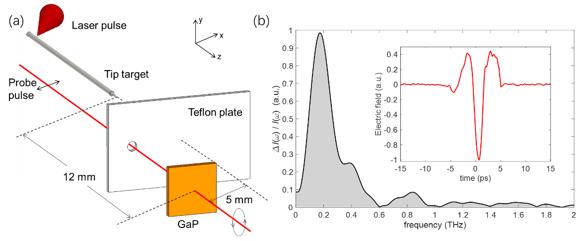The super intense terahertz source has wide applications in the manipulation of the transient state of matters. So far, the highest THz energy and field strength are achieved by means of laser interaction with thin foils. However, the transition radiation or sheath acceleration radiation that underlies this source would generally lead to a low laser-to-THz conversion efficiency (generally below 0.1%) and large divergence angle.
In 2017, an alternatively method based on femtosecond laser-driven metal wires was proposed by a research team from Shanghai Institute of Optics and Fine Mechanics, Chinese Academy of Sciences. The method conceptually mimics a gyrotron-like undulator that produces coherent THz radiations. In the proof of principle experiment, about 28 μJ THz in the 0.1-3 THz range was generated by irradiating a ~3 mJ laser pulse onto a metal wire, demonstrating an incredible conversion efficiency approaching ~1%.
Recently, this research group has achieved new progress on the intense THz pulse generation. By irradiating a 700 mJ femtosecond laser pulse onto a metal wire, about 3 mJ THz pulse was detected, which signified the highest achieved THz energy from a sub-Joule driving laser energy. Related work was published on Optics Express.
In the experiment, coherent THz radiation was attributed to a portion of the initial femtosecond electrons that gyrated along the wire target—just like the undulator in a FEL. This interesting “micro undulator” emerged spontaneously with the laser irradiation as a transient radial electric field was established by charge separation and then steered the portion of electrons to circle around the wire.
Afterwards, thanks to the waveguide nature of the metal wires, THz was coupled and guided along on the wire in the form of a surface wave. By further employing this scheme to a tip target which has a 500 nm curvature at the end, the spatially concentrated sub-wavelength focusing of the THz wave eventually contributed to a record THz near field strength of 90 GV/m at close vicinity of the tip apex.
This work demonstrates the promising potential of the THz source and marks a significant progress toward the application of intense THz source.
The research was supported by the National Natural Science Foundation of China; Shanghai Rising-Star Program; the Strategic Priority Research Program (B)

(a) Experiment setup; (b) Emitted THz power spectrum and electric field waveform (inset). (Image by SIOM)
Article website:
https://doi.org/10.1364/OE.390764
Contact:
Mr. CAO Yong
General Administrative Office
Shanghai Institute of Optics and Fine Mechanics, CAS
Email: caoyong@siom.ac.cn